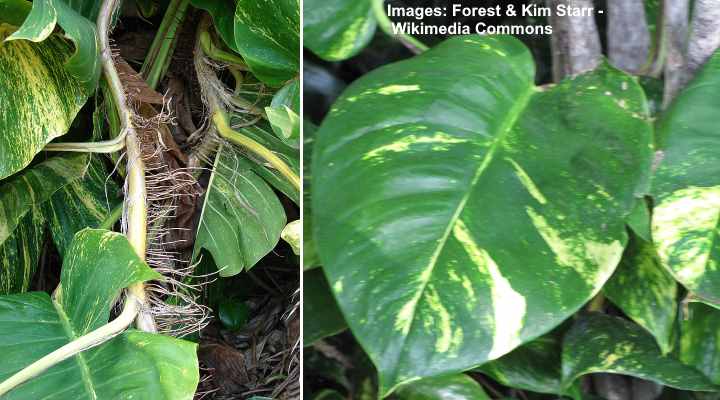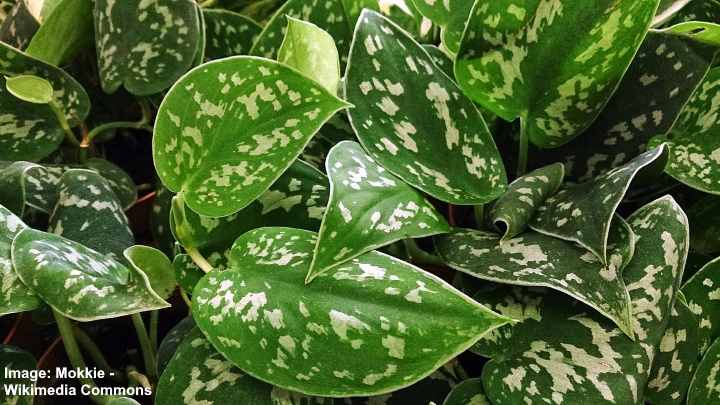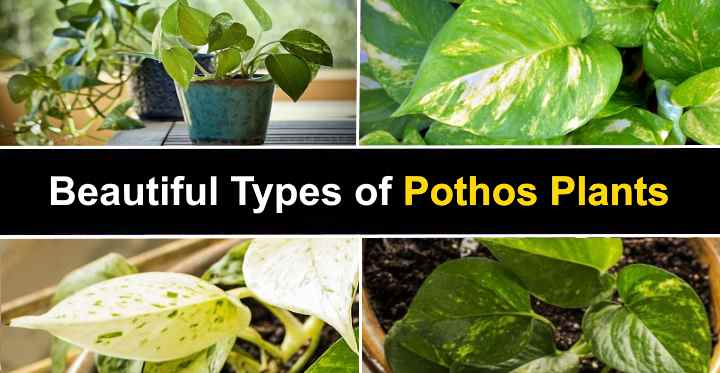Pothos (Epipremnum aureum) is a vine plant with heart-shaped leaves that has long trailing stems. Pothos plants may be cultivated indoors easily, requiring only a little attention. In hanging baskets or pots, tropical indoor plants look stunning. There are many scientific and popular names for Pothos plants. As a result, the type of variegation on their glossy, leathery leaves is commonly used to identify specific varieties.
Epipremnum aureum, the common name for Pothos plants, is often used. Scindapsus aureus, Rhaphidophora aurea, and Epipremnum pinnatum are scientific names for them in some countries. We’ll call all pothos cultivars by their most prevalent name, Epipremnum aureum, in this article to prevent confusion.
Pothos plants are sometimes referred to by a variety of scientific names, but also by a variety of common names. Devil’s ivy, silver vine, marble queen, taro vine, and golden pothos are all names for plants in the Epipremnum aureum genus. Certain plants, such as neon pothos, have lime-green leaves and are sometimes referred to by their common name. It might be the way it grows. A heartleaf philodendron is a different species entirely, so the plant is misnamed.
Types of pothos plants: The Golden pothos, neon pothos, pearl and jade pothos, and marble queen pothos are the most common plants in the Epipremnum aureum genus. The leaf variegation distinguishes between the types of pothos. Some pothos have dull dark leaves, while others have brilliant lemon and lime-colored leaves. Others have green and white leaves.
How to care for pothos plants: When grown in moist potting soil with excellent drainage, devil’s ivy plants thrive in bright indirect light. Humidity should be high, and temperatures should be between 65°F and 85°F (18°C and 29°C) for optimum growth. Prune the stems to encourage a bushier appearance, and only water when the soil is somewhat dry. During the growing season, fertilize every month.
Type of Pothos (With Pictures)
Let’s explore the various sorts of Epipremnum aureum in greater depth. There are ten different varieties of “genuine” pothos plants in this list, as well as two plants with the common name pothos. Scindapsus pictus includes these two plants: satin pothos and Trebi pothos.
Jade Pothos

The original variety of pothos plant, Epipremnum aureum ‘jade pothos,’ has just minimal variegation on the black green heart-shaped leaves. Since it is so simple to care for, this kind of pothos became popular as a houseplant. The dense foliage of devil’s ivy may be trimmed to make an attractive table plant, which is also known as devil’s ivy.
Indoors, jade pothos plants have up to 3 ft. (90 cm) of stems, similar to all Epipremnum aureum plants. A hanging basket is adorned with these leafy vines, which cascade beautifully. If you want a floor planter to offer a vertical emphasis, try growing the climbing plant up a moss pole.
Jade pothos is a suitable plant for low light or shaded areas and grows well in bright light. Jade pothos is a great shower plant because it requires little sunlight and high humidity, which are not required for most other plants.
Golden Pothos (Epipremnum aureum)

Because of its light lime-colored leaves with yellow variegation, Epipremnum aureum (common name: Golden Pothos or Devils Ivy) is one of the most popular hanging basket plants. Its leaf patterns are like delicate brushstrokes, and it has a lemon color. This pothos plant brightens up dark corners by adding glossy leaves.
The golden pothos’s exceptional low-light qualities are one of its most notable characteristics. In low light, most plants with variegated leaves lose their vibrancy. Even in low light situations, the golden pothos maintains its brilliant variegation.
Because of this, golden pothos is a wonderful bedroom plant since light is often scarce. The golden pothos is on NASA’s list of recommended clean air houseplants, as are all varieties of pothos plants.
Marble Queen Pothos

The highly variegated leaves of Epipremnum aureum ‘marble queen’ (marble queen pothos) are more cream-colored than green. With its striking marble leaves, this bright trailing plant makes a stunning display piece in any room. This plant thrives in bright, indirect sunlight because of its deep variegation.
The pothos marble has a moderate growth rate, making it easier to care for. The bushy look of the Marble Queen, for example, makes her easier to maintain. Moreover, unlike other pothos cultivars, it doesn’t need to be repotted as often.
Neon Pothos

Due to the brilliantly colored, almost translucent brilliant green leaves, Epipremnum aureum ‘Neon Photos’ is known as the “neon pothos.” The dazzling vivid color of the leaves and its bushy appearance are impossible to resist when looking at photos of this neon green pothos.
In hanging baskets or containers on tall plant stands, neon pothos plants thrive and are excellent. If you want to put it in a difficult-to-reach area, you can also grow this pothos in water. Keep it in a bright area with filtered light, and only water when the top 1 inch (2.5 cm) of soil is dry, as with most variegated pothos plants.
Manjula Pothos (Epipremnum aureum ‘Manjula’)
With lovely cream and green leaves, the Manjula pothos is a stunning plant. Several leaves are virtually pure white with just traces of green because of the variegation. Green and white marbled effects can be seen on some leaves. This plant is a patented variety of pothos, also known as the Epipremnum ‘happy leaf.’
In garden centers, it might be difficult to locate a Manjula pothos. To maintain the foliage of this unusual variegated pothos vibrant, there are certain care requirements. The plant should be kept in a bright area but not exposed to direct sunlight. The white variegation will fade if you get too much sunlight.
Pearls and Jade Pothos

The Epipremnum aureum ‘Pearls and Jade’ (also known as the ‘N’Joy’ pothos) is a little-leaf variety of pothos seen in the photo. The leaves are emerald green with white, cream, and occasionally gray markings in this variety, which has green and white variegation.
This plant is a fantastic pot plant for a desktop or office desk because of its sluggish development. This cultivar is more difficult than other pothos cultivars when it comes to caring for the plant. This variety of pothos requires the soil to be regularly moist, unlike most other varieties that are drought-resistant. The lovely leaves will wilt if there is not enough moisture.
Glacier Pothos
The engaging vining plant with little heart-shaped leaves is known as the slow-growing pothos (the ‘Glacier’ pothos). The green leaves with silver and gray specks, which may be comparable to the ‘Pearls and Jade cultivar, are variegated. The glacier pothos is a great potted plant for tables and desks because of its bushy growth habit.
The size of the Epipremnum aureum ‘Glacier’ is comparable to that of the pothos called ‘Pearl and Jade.’ This multicolored cultivar thrives in low-light environments and may sustain average room humidity. However, faster growth can be encouraged by keeping humidity levels high and in bright light.
Cebu Blue Pothos
The cultivar known as the Cebu Blue is one of the most unusual types of pothos. The elongated heart-shaped leaves of this Epipremnum variety are a distinguishing characteristic. The leaves have a lanceolate shape rather than a rounded shape. The Cebu Blue has lustrous silvery-blue leaves with fascinating veined patterns, as opposed to other pothos types.
This plant thrives in bright, indirect sunlight, just like all other types of pothos. Just supply the houseplant with enough water to keep the soil moist and maintain a high humidity level.
Hawaiian Pothos

In comparison to other kinds of hanging pothos plants, Epipremnum aureum Hawaiian has enormous leaves. Little yellow variegations dot the dark green leaves. When hanging from a basket or growing up a pole, the long vines and large leaves create an attractive vertical accent. Pruning may help to maintain a small shrub growth habit while also limiting stem length.
Jessenia Pothos
A new pothos cultivar, Epipremnum aureum ‘Jessenia,’ is gaining popularity. The leaves have a lemon-yellow variegation and are emerald green. Some of the leaves are nearly pure golden yellow, while others have a marbling effect. The Jessenia pothos is a uncommon, difficult-to-find kind of houseplant because to its popularity.
Satin Pothos

The satin pothos, silver pothos, and silver Philodendron are all popular names for Scindapsus pictus ‘Argyraeus,’ but it’s not a real pothos nor Philodendron. Scindapsus pictus is the genus in which this cultivar belongs. It shares many of the characteristics of pothos that make it so popular, however. A climbing plant with dark green matte leaves, the satin pothos is a popular plant. It’s called the silver satin pothos because its leaves have silvery spots.
When identifying satin pothos, it’s a common mistake to mistake it with Philodendron silver. Heart-shaped leaves and long, trailing vines characterize both of these plants. Yet, they are not genuine pothos plants because neither belongs to the genus Epipremnum.
Trebi Pothos

Since it comes from the genus Scindapsus, the Trebi pothos is linked to the satin pothos. Despite its popular name, the pothos cultivar known as “Trebi” isn’t a genuine variety. The satin pothos has more variegation than this vining houseplant with large green leaves.
The plant has a silver-blue appearance because of the matte foliage’s silver marbling effect. The Trebi cultivar is not as bright and vibrant as other pothos cultivars, when compared to true pothos plants. The following cultivars are similar to the pothos cultivar ‘Trebi.
- Scindapsus pictus ‘Argyraeus,’ The light silvery variegation on dark green leaves gives it a delicate sparkle.
- Scindapsus pictus ‘Exotica’ Plant is a silver-splashed variant of the Trebi that looks a lot like it.
- Scindapsus pictus ‘Silver Ann’ The leaves are lighter in color than the rest of the plant.
How to Care for Pothos or Devil’s Ivy (Epipremnum Aureum)
Epipremnum aureum plants are usually easy to care for. Houseplants may grow in low to medium light and thrive in a variety of conditions. Nonetheless, they require the correct level of care like all houseplants, whether hardy or not. When caring for pothos plants, there are a few important things to remember.
Pothos care: light requirements
In bright, indirect light, grow devil’s ivy (pothos) plants. Pothos plants grow quicker and retain their variegationbrightness with plenty of light. Low- to minimal-light conditions are better for darker-leafed pothos plants. Always keep the plants away from sunlight.
The best soil for growing pothos indoors
Pothos plants need a well-draining potting medium that retains moisture. For all types of pothos, an excellent potting media consists of equal parts of potting soil, peat moss, and perlite. Excess moisture will harm the roots if the soil gets waterlogged due to poor drainage.
When to water potted pothos plants
Water pothos plants when the top 1–2 inches (2.5–5 cm) of soil is completely dried out. Press firmly on the potting mix when growing in hanging baskets or pots. It’s time to water the plant if the potting mix is dry. If the soil feels damp, wait until it has dried more. Water a pothos only as often as it needs, based on the dryness of the soil.
How to water a pothos—Pour enough water in the pot to flow out at the bottom when the soil is partially dry. The roots are nourished and diseased ones are prevented by this deep watering technique. For further information on watering houseplants, please see our article.
Temperature and humidity for pothos houseplants
Pothos plants prefer a temperature range of 65°F to 85°F (18°C to 29°C) to thrive. As a result, these trailing houseplants thrive in an environment with a comfortable temperature. Pothos requires medium to high humidity, as it is a tropical plant. In your room, aim for at least 40% humidity.
Fertilizer to encourage healthy pothos growth
During the growing season, apply a diluted houseplant fertilizer once a month for optimum development. Stop fertilizing during the winter since pothos develops at a leisurely pace. In the spring, you may also employ a slow-release fertilizer. As often as you water the plant, this will supply plant nutrients.
How to prune a pothos plant
Because pothos plants have a medium to slow growth, pruning them is not usually required. If vines get excessively long or you want to encourage bushy development, you may prune them back. Brown, dead, or decaying leaves and stems must be trimmed off. In the spring, just before a pothos begins to grow vigorously, is when you should prune it.
